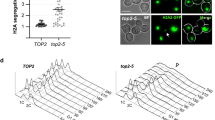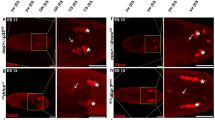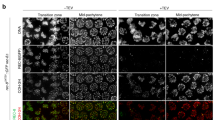Abstract
Mutations in the embryonic Drosophila Grapes/Chk1 checkpoint result in an abbreviated interphase, chromosome condensation defects and metaphase delays. To clarify the relationship between these phenotypes, we simultaneously timed multiple nuclear and cytoplasmic events in mutant grp-derived embryos. These studies support a model in which grp disrupts an S-phase checkpoint, which results in progression into metaphase with incompletely replicated chromosomes. We also show that chromosome condensation is independent of the state of DNA replication in the early embryo. Therefore, grp condensation defects are not a direct consequence of entering metaphase with incompletely replicated chromosomes. Rather, initiation of chromosome condensation (ICC) occurs at the normal time in grp-derived embryos, but the shortened interval between ICC and metaphase does not provide sufficient time to complete condensation. Our results suggest that these condensation defects, rather than incomplete DNA replication, are responsible for the extensive metaphase delays observed in grp-derived embryos. This analysis provides an example of how the loss of a checkpoint can disrupt the timing of multiple events not directly monitored by that checkpoint. These results are likely to apply to vertebrate cells and suggest new strategies for destroying checkpoint-compromised cancer cells.
This is a preview of subscription content, access via your institution
Access options
Subscribe to this journal
Receive 12 print issues and online access
$209.00 per year
only $17.42 per issue
Buy this article
- Purchase on Springer Link
- Instant access to full article PDF
Prices may be subject to local taxes which are calculated during checkout





Similar content being viewed by others
References
Hartwell, L. H. & Weinert, T. A. Checkpoints: controls that ensure the order of cell cycle events. Science 246, 629–634 (1989).
Weinert, T. A. & Hartwell, L. H. The RAD 9 gene controls the cell cycle response to DNA damage in Saccharomyces cerevisiae. Science 241, 317–322 (1988).
Fogarty, P. et al. The Drosophila grapes gene is related to checkpoint gene chk1/rad27 and is required for late syncytial division fidelity. Curr. Biol. 7, 418–426 (1997).
Sibon, O. C., Stevenson, V. A. & Theurkauf, W. E. DNA-replication checkpoint control at the Drosophila midblastula transition. Nature 388, 93–97 (1997).
Rhind, N., Furnari, B. & Russell, P. Cdc 2 tyrosine phosphorylation is required for the DNA damage checkpoint in fission yeast. Genes Dev. 11, 504–511 (1997).
Furnari, B., Rhind, N. & Russell, P. Cdc 25 mitotic inducer targeted by chk 1 DNA damage checkpoint kinase. Science 277, 1495–1497 (1997).
Sanchez, Y. et al. Conservation of the Chk 1 checkpoint pathway in mammals: linkage of DNA damage to Cdk regulation through Cdc 25. Science 277, 1497–1501 (1997).
Peng, C. Y. et al. Mitotic and G 2 checkpoint control: regulation of 14-3-3 protein binding by phosphorylation of Cdc25 C on serine-216. Science 277, 1501–1505 (1997).
Walworth, N. C. & Bernards, R. rad-dependent response of the chk1-encoded protein kinase at the DNA damage checkpoint. Science 271, 353–356 (1996).
Walworth, N., Davey, S. & Beach, D. Fission yeast chk1 protein kinase links the rad checkpoint pathway to cdc2. Nature 363, 368–371 (1993).
O'Connell, M. J., Raleigh, J. M., Verkade, H. M. & Nurse, P. Chk1 is a wee1 kinase in the G2 DNA damage checkpoint inhibiting cdc 2 by Y15 phosphorylation. EMBO J. 16, 545–554 (1997).
Chen, L., Liu, T. H. & Walworth, N. C. Association of Chk1 with 14-3-3 proteins is stimulated by DNA damage. Genes Dev. 13, 675–685 (1999).
Lopez-Girona, A., Furnari, B., Mondesert, O. & Russell, P. Nuclear localization of Cdc 25 is regulated by DNA damage and a 14-3-3 protein. Nature 397, 172–175 (1999).
Zeng, Y. et al. Replication checkpoint requires phosphorylation of the phosphatase Cdc 25 by Cds 1 or Chk1. Nature 395, 507–510 (1998).
Kumagai, A., Yakowec, P. S. & Dunphy, W. G. 14-3-3 proteins act as negative regulators of the mitotic inducer Cdc25 in Xenopus egg extracts. Mol. Biol. Cell 9, 345–354 (1998).
Pines, J. Cell cycle. Checkpoint on the nuclear frontier. Nature 397, 104–105 (1999).
Yang, J. et al. Control of cyclin B1 localization through regulated binding of the nuclear export factor CRM1. Genes Dev. 12, 2131–2143 (1998).
Huang, J. & Raff, J. W. The disappearance of cyclin B at the end of mitosis is regulated spatially in Drosophila cells. EMBO J. 18, 2184–2195 (1999).
Fogarty, P., Kalpin, R. F. & Sullivan, W. The Drosophila maternal-effect mutation grapes causes a metaphase arrest at nuclear cycle 13. Development 120, 2131–2142 (1994).
Su, T. T., Campbell, S. D. & O'Farrell, P. H. Drosophila grapes/CHK1 mutants are defective in cyclin proteolysis and coordination of mitotic events. Curr. Biol. 9, 919–922 (1999).
Raff, J. W. & Glover, D. M. Nuclear and cytoplasmic mitotic cycles continue in Drosophila embryos in which DNA synthesis is inhibited with aphidicolin. J. Cell Biol. 107, 2009–2019 (1988).
Debec, A. et al. Live analysis of free centrosomes in normal and aphidicolin-treated Drosophila embryos. J. Cell Biol. 134, 103–115 (1996).
Clarkson, M. & Saint, R. A His2AvDGFP fusion gene complements a lethal His2AvD mutant allele and provides an in vivo marker for Drosophila chromosome behavior. DNA Cell. Biol. 18, 457–462 (1999).
Buchenau, P., Saumweber, H. & Arndt-Jovin, D. J. Consequences of topoisomerase II inhibition in early embryogenesis of Drosophila revealed by in vivo confocal laser scanning microscopy. J. Cell Sci. 104, 1175–1185 (1993).
Roberge, M., Th'ng, J., Hamaguchi, J. & Bradbury, E. M. The topoisomerase II inhibitor VM-26 induces marked changes in histone H1 kinase activity, histones H1 and H3 phosphorylation, and chromosome condensation in G2 phase and mitotic BHK cells. J. Cell Biol. 111, 1753–1762 (1990).
Newport, J. & Spann, T. Disassembly of the nucleus in mitotic extracts: membrane vesicularization, lamin disassembly, and chromosome condensation are independent processes. Cell 48, 219–230 (1987).
Novitsky, E., Grace, D. & Strommen, C. The entire compound autosomes of Drosophila melanogaster. Genetics 98, 257–273 (1981).
Sullivan, W., Daily, D. R., Fogarty, P., Yook, K. J. & Pimpinelli, S. Delays in anaphase initiation occur in individual nuclei of the syncytial Drosophila embryo. Mol. Biol. Cell 4, 885–896 (1993).
Booher, R. N., Alfa, C. E., Hyams, J. S. & Beach, D. H. The fission yeast cdc2/cdc13/suc1 protein kinase: regulation of catalytic activity and nuclear localization. Cell 58, 485–497 (1989).
Edgar, B. A., Sprenger, F., Duronio, R. J., Leopold, P. & O'Farrell, P. H. Distinct molecular mechanism regulate cell cycle timing at successive stages of Drosophila embryogenesis. Genes Dev. 8, 440–452 (1994).
Sibon, O. C., Kelkar, A., Lemstra, W. & Theurkauf, W. E. DNA-replication/DNA-damage-dependent centrosome inactivation in Drosophila embryos. Nature Cell Biol. 2, 90–95 (2000).
Rudner, A. D. & Murray, A. W. The spindle assembly checkpoint. Curr. Opin. Cell Biol. 8, 773–780 (1996).
Megraw, T. L., Li, K., Kao, L. R. & Kaufman, T. C. The centrosomin protein is required for centrosome assembly and function during cleavage in Drosophila. Development 126, 2829–2839 (1999).
de Saint Phalle, B. & Sullivan, W. Spindle assembly and mitosis without centrosomes in parthenogenetic Sciara embryos. J. Cell Biol. 141, 1383–1391 (1998).
Levine, A. J. p53, the cellular gatekeeper for growth and division. Cell 88, 323–331 (1997).
Zakian, V. A. ATM-related genes: what do they tell us about functions of the human gene? Cell 82, 685–687 (1995).
Paulovich, A. G., Toczyski, D. P. & Hartwell, L. H. When checkpoints fail. Cell 88, 315–321 (1997).
Sullivan, W., Fogarty, P. & Theurkauf, W. Mutations affecting the cytoskeletal organization of syncytial Drosophila embryos. Development 118, 1245–1254 (1993).
Francis-Lang, H., Minden, J., Sullivan, W. & Oegema, K. in Confocal Microscopy Methods and Protocols (ed. Paddock, S. W.) (Humana Press, Totowa, 1999).
Acknowledgements
We thank J. Sisson, T. Su and S. Campbell for their critical reading of the manuscript and helpful discussions. We thank Tao-Shih Hsieh for providing VM26 and Arshad Desai for labelled histones. This work was supported by grants to W.S. from the National Institutes of Health (5R01 GM 46409-08), and to R.S. by the Australian Research Council (A09601106). Support for K.Y. was provided by a University of California Biotechnology Training Grant and an NIH Training grant (1T32GM0864601A1)
Author information
Authors and Affiliations
Corresponding author
Rights and permissions
About this article
Cite this article
Yu, K., Saint, R. & Sullivan, W. The Grapes checkpoint coordinates nuclear envelope breakdown and chromosome condensation. Nat Cell Biol 2, 609–615 (2000). https://doi.org/10.1038/35023555
Received:
Revised:
Accepted:
Published:
Issue Date:
DOI: https://doi.org/10.1038/35023555
This article is cited by
-
Overexpression of the Drosophila ATR homologous checkpoint kinase Mei-41 induces a G2/M checkpoint in Drosophila imaginal tissue
Hereditas (2018)
-
Chk1
AfCS-Nature Molecule Pages (2007)
-
Chromosomes with delayed replication timing lead to checkpoint activation, delayed recruitment of Aurora B and chromosome instability
Oncogene (2007)



